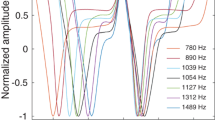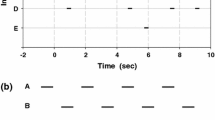Abstract
Rhythmic “circa-second” contrations of larvae of the hornetVespa orientalis, believed to serve as hunger signals, were studied. A considerable degree of coordination among individual larvae, both in frequency and phase of these contractions, has been observed. The oscillations of singly isolated larvae are of short duration, non-constant, with increasing intervals in between and there is a substantial variability in the patterns shown by different larvae. In contrast, the association of two or more larvae leads to enhancement of their periodic behaviour and to (partial) entrainment. Communication among larvae may perhaps be mediated by the sound pulses (“scratching” noises) which are generated by these contractions. We have subjected individual and grouped larvae to external sound pulses and were able to demonstrate: (a) enhancement of rhythmic activity; (b) phase resetting; (c) entrainment to an external oscillator within a range of frequencies; (d) the existence of a subharmonic mode of entrainment. We propose a simple phenomenologic model to account for these larvae responses. Our model assumes the existence of an “energy” variable which declines with time but is upgraded, in a phase-dependent way, by external stimuli.
Similar content being viewed by others
Literature
Frauenthal, J. C. 1979.Introduction to Population Modelling (UMAP Monograph Series), pp. 59–73. Stuttgart: Birkhäuser.
Gontarski, H. 1941. “Lautauserungen bei Larven der Hornisse (Vespa crabro).”Natur Volk. 71, 291.
Hanson, F. E. 1978. “Comparative Studies of Firefly Pacemakers.”Fed. Proc. 37, 2158–2164.
Ishay, J. 1976. “Acoustical Communication in Wasps Colonies (Vespinal)”, In:Proceedings of the XVth International Congress of Entomology Washington D.C., pp. 406–435.
—, A. Motro, S. Gitter and M. B. Brown. 1974. “Rhythms in Acoustical Communication by the Oriental HornetVespa orientalis.”Anim. Behav. 22, 741–744.
Pavlidis, T. 1973.Biological Oscillators: Their Mathematical Analysis, p. 207. New York: Academic Press.
Rowe, G. W. and J. F. Harvey. 1985. “Information Content in Finite Sequences: Communication Between Dragonfly Larvae.”J. theor. Biol. 116, 275–290.
Schaudinischky, L. and J. Ishay. 1968. “On the Nature of the Sounds Produced Within the Nest of the Oriental HornetVespa orientalis (Hymenoptera).”J. Acous. Soc. Am. 44, 1290–1301.
Walker, T. J. 1969. “Acoustic Synchrony: Two Mechanisms in the Snowy Tree Cricket.”Science 166, 891–894.
Wilson, E. O. 1971.The Insect Societies, p. 548. Cambridge, MA: Belknap Press.
Author information
Authors and Affiliations
Additional information
Based in part on work performed by V. Barenholz-Paniry in partial fulfillment of the requirements for the M.Sc. degree from the Sackler Faculty of Medicine, Tel Aviv University, 1986.
Rights and permissions
About this article
Cite this article
Barenholz-Paniry, V., Ishay, J.S. & Grossman, Z. Rhythmic signalling and entrainment inVespa orientalis larvae: Characterization of the underlying interactions. Bltn Mathcal Biology 50, 661–679 (1988). https://doi.org/10.1007/BF02460095
Received:
Revised:
Issue Date:
DOI: https://doi.org/10.1007/BF02460095




